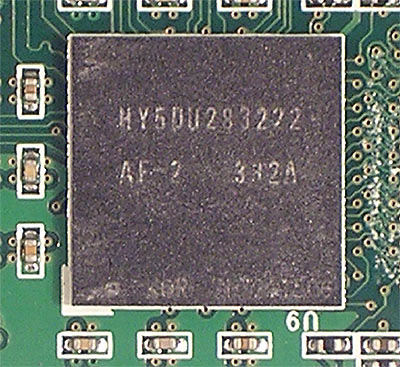MSI GeForce FX 5950 Ultra
MSI FX5950 Ultra VTD256 Features
Retail bundle
The huge package box with a special handle to carry it around contained the following:
- The graphics board itself;
- Power cable for the video controller fan;
- S-Video cable;
- VIVO-adapter;
- DVI-to-D-Sub adapter;
- Pocket-book with a MSI logo;
- 5 gaming CDs in a smart package (The Elder Scrolls: Morrowind, Ghost Recon, Duke Nuken: Manhattan Project, Games Collection CD: The Sum of All Fears, IL-2 Sturmovik, Serious Sam: The Second Encounter, Rally Trophy, Beam Breakers, Zax: The Alien Hunter, Oni);
- 6 CDs with drivers and software including MSI's own developments;
- Raised-relief "MSI" logo sticker.

As always, MSI stands out with its superb package bundle. Not only does the company an artistic job equipping its top-end products built on the latest NVIDIA chips, nor Low-End as well as Middle-End products are ignored. What makes this package bundle different from other retail kits of the company and other manufacturers of video cards built on the NVIDIA GeForce FX 5950 Ultra is of course the smart pocket-book bearing an MSI logo. Some time ago, the distinguishing feature of video cards built on NVIDIA GeForce FX 5600 in the MSI version was an 800 dpi optical mouse in the "N-BOX" kit.
Design and board layout
The MSI board's PCB design is completely identical to NVIDIA's reference board. There aren't any differences in either the component layout nor even in the positioning of capacitors. The cooling system also follows the reference, with the difference that MSI's own sticker reminds you whose make the board is.
The board itself proved to be quite massive. Of course, this is due to the quite massive cooling system (for more detail, read below) with copper radiators which add such formidable weight to the card. It looks like starting from NV30 we've been increasingly inured that video cards have to be heavy, coolers big, and prices for these cards transcendental =). Never mind, this is a separate topic.
The video card offers a classical dark green PCB, 256 MB DDR onboard with a 256-bit data transmission bus (8 chips, 32 bit each, positioned over the front and rear sides of the PCB). The video card offers the AGP 2x/4x/8x interface and a standard set of outputs: one DVI-I, one analogous, and one TV-OUT.
The signal for digital monitors is formed by the Sil164CT64 TMDS-transmitter made by Silicon Image.
The board also offers a SAA7108AE VIVO-chip made by Philips.
Besides, on the front side of the PCB you can see a connector for additional power necessary for video cards built on NVIDIA GeForce FX 5950. Additional power doesn't have to be applied, but in this case the card would run at reduced speeds, of which it will earnestly report upon the very first boot-up of Windows. The design shortcoming of the additional power connector on MSI GeForce FX 5950 Ultra is its vertical positioning. First, it's quite difficult to apply power with an AGP video card already fitted in place. Secondly, the fastening of the connector leaves much to be desired. But that's already a problem of all FX 5900 Ultra video cards, and now NVIDIA's 5950 boards, so it doesn't make sense addressing all the claims to MSI.

There is an advanced BGA-packaging for memory chips made by Hynix (HY5DU283222). The access time of memory chips is 2 ns, which is equivalent to 500 MHz (1000 MHz), but the memory runs at the specified 475 MHz (950) which is prescribed by NVIDIA for GeForce FX 5950 Ultra. In other words, the card offers a small margin of memory overclocking. The GPU operating speed is 475 MHz, which also meets the frequency recommended by NVIDIA.
Of course we can't pass over the cooling system of the MSI GeForce FX 5950 Ultra in silence. At first glance, it may seem we have come back to FlowFX again. In fact, all is not the way it seems. Yes, the system looks clumsy and awkward, but the operating principle is already different. The air for cooling the radiator that covers the NV38 graphic chip is sucked from outside through the grid in the fastening plane of the video card.
The air entrapped by the turbine from outside is directed to the massive radiator that tightly covers the graphic chip. After the radiator is cooled by the air applied from outside falls inside the housing (already heated from the radiators). Of course this will not effect positively on the overall temperature inside the CPU unit, but the video card will always be blown about by the external cool air. The RPM rate is quite high, which makes much noise, but the noise level is much lower than that of FlowFX, and you can easily put up with it.
On top of it all, the card has pretensions of 2 slots at a time: AGP and the first PCI. The board is lengthy enough, so small-scale housings will be an issue. All the dimensions of the new NVIDIA's offspring make themselves felt.
 |
Content: |
 |
|
 |
Top Stories: |
 |
 |
 |
MoBo:


|
 |
 |
 |
VGA Card:


|
 |
 |
 |
CPU & Memory:

|
|
|
